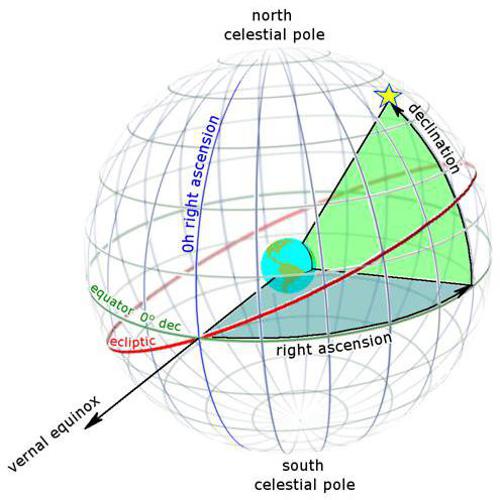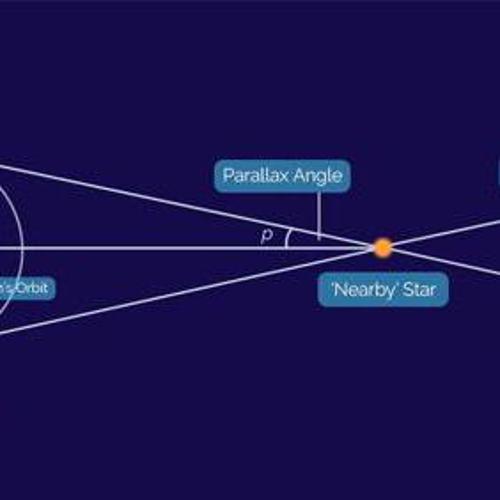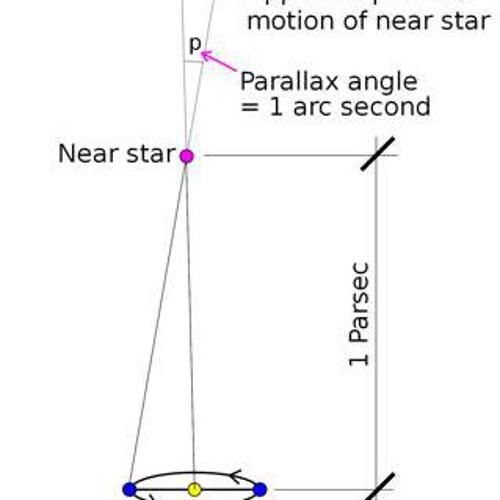Celestial sphere
The celestial sphere is the geometrical space of all the points situated at the same distance from the Earth. Since the stars are very distant, they appear to occupy positions on the surface of this sphere.
We can plot the sun’s annual trajectory in the sky on it, the resulting line is called the ecliptic.
Equatorial coordinate system
Around the celestial sphere’s equator we measure Right Asension in hours (one hour = 15°). The intersection between the ecliptic, the celestial equator and the projection the Greenwhich meridian is called the vernal point, denoted by $\gamma$. $\gamma$ is considered to lie at RA 0h, and going east RA increases by one hour for every 15° traveled.
Earth’s latitude circles are projected onto the celestial sphere and called Declination circles. We have 90° of positive DEC north of the Equator and 90° of negative DEC south of the Equator.
Note: stars with an angular DEC distance from the pole that’s lower than the observer absolute latitude are circumpolar, meaning they never rise or set.
Magnitude
In a clear night, without moonlight, with our naked eye we can see from 2500 to 3000 stars. About the same number are hidden away below the horizon. However there are infinitely more celestial bodies than these.
An object’s apparent brightness to a sensor is said to be its apparent magnitude. This is based on how the object is observed from Earth, meaning it depends on the distance, its luminosity and the extinction. The higher the value, the fainter an object is. Visual magnitude is usually denoted by $m$ or $m_v$.
The absolute magnitude ($M$) describes the intrinsic luminosity emitted by an object and is defined to be equal to the apparent magnitude that the object would have if it were placed at a certain distance from Earth, 10 parsecs for stars.
Distances
Parallax, $p$ or $\pi$
Parallax (from Ancient Greek παράλλαξις (parallaxis)), meaning ‘alternation’ is a displacement or difference in the apparent position of an object viewed along two different lines of sight, and is measured by the angle or semi-angle of inclination between those two lines. Due to foreshortening, nearby objects show a larger parallax than farther objects when observed from different positions, so parallax can be used to determine distances.
To measure large distances, such as the distance of a planet or a star from Earth, astronomers use the principle of parallax. Here, the term parallax is the semi-angle of inclination between two sight-lines to the star, as observed when Earth is on opposite sides of the Sun in its orbit.
Parsec, $pc$
One parsec is the distance from Earth to a point whose parallax p = 1” (arcsecond).
For small angles, the distance to an object: $d_{(pc)}=\frac{1}{p_{(arcsecond)}}$.
$~1pc = 3.26ly$
Note: we can only measure parallaxes $p > 0.001” (~1000pc)$, because of atmospheric distortion.
Atmospheric effects
Transparency and seeing
Transparency defines the clarity of the atmosphere, and affects the quality of images obtained through a telescope and of astrophotos. It’s determined by your altitude, weather conditions, dust particles floating around etc.
It is measured on the Antoniadi scale:
- I Perfect seeing without a quiver of turbulence at all.
- II Slight shimmers; moments of stillness last several seconds.
- III Average seeing; larger air tremors blur the view.
- IV Poor views with a constant and disturbing swell.
- V Bad views with severe undulations; so unstable that even quick sketches are out of the question.
Light pollution [1]
Light pollution is measured using the Bortle scale.
|
Class |
Title |
NELM |
Approx. SQM1 mag/arcsec2 |
Description |
Color |
|---|---|---|---|---|---|
|
1 |
Excellent dark-sky site |
7.6–8.0 |
21.7–22.0 |
the zodiacal light is visible and colorfulthe gegenschein is visiblethe zodiacal band is visibleairglow is readily visiblethe Scorpius and Sagittarius regions of the Milky Way cast obvious shadowsmany constellations, particularly fainter ones, are barely recognizable amid the large number of starsmany Messier and globular clusters are naked-eye objectsM33 is a direct vision naked-eye objectlimiting magnitude with reflector is 17.5 (with effort)Venus and Jupiter affect dark adaptation |
Black |
|
2 |
Typical truly dark site |
7.1–7.5 |
21.5–21.7 |
the zodiacal light is distinctly yellowish and bright enough to cast shadows at dusk and dawnairglow may be weakly visible near horizonclouds are only visible as dark holes against the skysurroundings are barely visible silhouetted against the skythe summer Milky Way is highly structuredmany Messier objects and globular clusters are naked-eye objectsM33 is easily seen with naked eyelimiting magnitude with 12.5” reflector is 16.5 |
Gray |
|
3 |
Rural sky |
6.6–7.0 |
21.3–21.5 |
the zodiacal light is striking in spring and autumn, and color is still visiblesome light pollution evident at the horizonclouds are illuminated near the horizon, dark overheadnearer surroundings are vaguely visiblethe summer Milky Way still appears complexM15, M4, M5, and M22 are naked-eye objectsM33 is easily visible with averted visionlimiting magnitude with 12.5” reflector is 16 |
Blue |
|
4 |
Rural/suburban transition |
6.1–6.5 |
20.4–21.3 |
the zodiacal light is still visible, but does not extend halfway to the zenith at dusk or dawnlight pollution domes visible in several directionsclouds are illuminated in the directions of the light sources, dark overheadsurroundings are clearly visible, even at a distancethe Milky Way well above the horizon is still impressive, but lacks detailM33 is a difficult averted vision object, only visible when high in the skylimiting magnitude with 12.5” reflector is 15.5 |
Green/Yellow |
|
5 |
Suburban sky |
5.6–6.0 |
19.1–20.4 |
only hints of zodiacal light are seen on the best nights in autumn and springlight pollution is visible in most, if not all, directionsclouds are noticeably brighter than the skythe Milky Way is very weak or invisible near the horizon, and looks washed out overheadwhen it is half moon (first/last quarter) in a dark location the sky appears like this, but with the difference that the sky appears dark bluelimiting magnitude with 12.5” reflector is 15 |
Orange |
|
6 |
Bright suburban sky |
5.1–5.5 |
18.0–19.1 |
the zodiacal light is invisiblelight pollution makes the sky within 35° of the horizon glow grayish whiteclouds anywhere in the sky appear fairly brighteven high clouds (cirrus) appear brighter than the sky backgroundsurroundings are easily visiblethe Milky Way is only visible near the zenithM33 is not visible, M31 is modestly apparentlimiting magnitude with 12.5” reflector is 14.5 |
Red |
|
7 |
Suburban/urban transition |
4.6–5.0 |
18.0–19.1 |
light pollution makes the entire sky light graystrong light sources are evident in all directionsclouds are brightly litthe Milky Way is nearly or totally invisibleM31 and M44 may be glimpsed, but with no detailthrough a telescope, the brightest Messier objects are pale ghosts of their true selveswhen it is full moon in a dark location the sky appears like this, but with the difference that the sky appears bluelimiting magnitude with 12.5” reflector is 14 |
Red |
|
8 |
City sky |
4.1–4.5 |
<18.0 |
the sky is light gray or orange – one can easily readstars forming familiar constellation patterns may be weak or invisibleM31 and M44 are barely glimpsed by an experienced observer on good nightseven with a telescope, only bright Messier objects can be detectedlimiting magnitude with 12.5” reflector is 13 |
White |
|
9 |
Inner-city sky |
4.0 |
<18.0 |
The sky is brilliantly litmany stars forming constellations are invisible and many fainter constellations are invisibleaside from the Pleiades, no Messier object is visible to the naked eyethe only objects to observe are the Moon, the planets, and a few of the brightest star clusters |
White |



